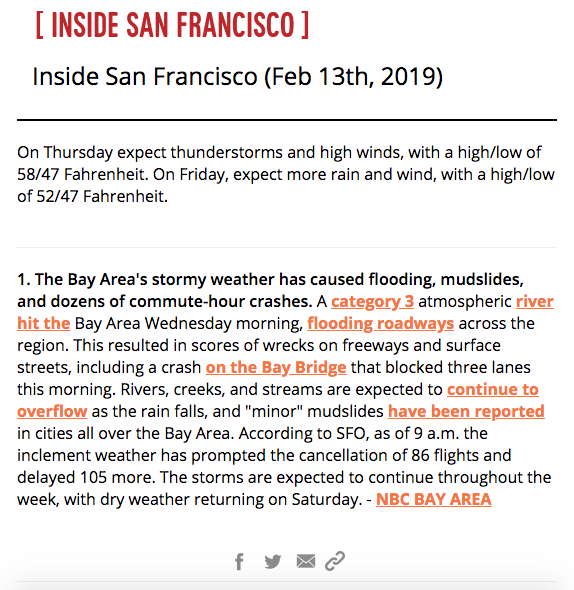
Surprise: Subscribers to a nerdy bitcoin newsletter are just about as engaged as subscribers to a nerdy local newsletter.
Inside.com, the startup that waited over a decade for the domain with its core product now in the inbox and not the browser, focuses on growing relationships using curated email newsletters to grab your attention. Last year, Inside saw $1.1 million in revenue, reached 750,000 active subscriptions, and circled a 40 percent open rate. With a recent $2.6 million fundraise — with more than 900 investors and $250,000 from founder/CEO Jason Calacanis — Inside’s topical newsletters are now joined by specific local newsletters for its main readership’s cities as well.
“Inside SF has been one of our highest performing open rates in terms of open rates and all the metrics we look at with these newsletters,” Austin Smith, Inside’s president and general manager, said. “I don’t think we’re well suited to solve local news because we’re doing curation, but we’re sending traffic to those publishers…We have tons of readers in all those cities and we can introduce them to it and get it off the ground with the initial audience.” Here’s a snippet:

“Those cities” aren’t exactly the places most parched for news, nor are the types of people Inside caters to under-advertised to; Inside San Francisco is now joined by Inside LA, Chicago, Boston, Portland, Seattle, DC, Austin, Denver, and Pittsburgh, among the other newsletters added as part of the fundraise/clues to their target demo: Inside Finance, HR, for CMOs, for CFOs, for CTO/CIOs, Marketing, for Founders, Sales, SaaS. (No Inside Food Stamps or Inside Affordable Housing here.)
Alongside Inside Beer, Inside Trump, yes, Inside Bitcoin, and a few dozen others, Inside’s goal is to be the definitive newsletter on each topic while building a massive scale to get there. The portfolio of 50 daily and twice-weekly newsletters are largely supported by advertising, though the company recently gave paid subscriptions and SMS (1. too unforwardable, 2. too clunky for ads, and 3. too expensive at scale) a go.
In 2017 the company launched a paid subscription option for premium access to one newsletter for $10/month or $25 for premium access to an unlimited number of Inside emails, removing ads. Smith said that now comprises just 10 to 15 percent of Inside’s overall revenue, with a thousand people out of the 750,000 active subscribers opting to pay. The SeedInvest campaign brought in supporter money in a different way, as “hundreds of our readers made investments between $1,000 and $5,000” according to Smith. Inside isn’t the first newsletter network to give it a shot, as local-focused Whereby.Us raised $250,000 via SeedInvest in 2017 — but advertising is definitely more valuable than reader revenue to the scaling startup, Smith said.“These newsletters are for a super highly engaged audience that is there to consume info, trusts us, and has made these newsletters a part of their daily media diet,” he said. “These ad units can work really well in these newsletters in a similar way to podcasts where we have this sophisticated audience that has tuned out programmatic and social ads, but a native ad appearing in a newsletter they trust…works well.”

Each newsletter has a publicly shown goal of how many email addresses are needed for the company to green-light it and how many are currently signed up, with 2,000 as the baseline. Exceptions include 1,000 needed for Inside Pets, and — sorry if you’re waiting for optimism — Inside Good News has the highest set goal of 7,000. That’s “not because we don’t like good news,” Smith said — but is a testament to the value they can sell the subscribers’ attention to advertisers at. (Each newsletter is curated by a human editor.) Other geography-focused newsletters are in the queue waiting for more subscribers, including Inside Asia, Africa, Brooklyn, Tokyo, Australia, Beijing, Moscow, and Washington.
Inside built an ad server that should help advertisers get more specific in their targeting, though Smith was careful to walk back from Facebook-level targeting.
“There were a lot of advertisers we worked with who are looking for more in terms of targeting who they would reach. For example, we worked with advertisers who want to reach developers. We have an Inside Dev with 10,000 subscribers and we all have another 75,000 or 80,000 across all newsletters, much more than just Inside Dev,” Smith said. “That was what led us to build this ad server where…we can put people into buckets — not super specific like Facebook — but big buckets.”